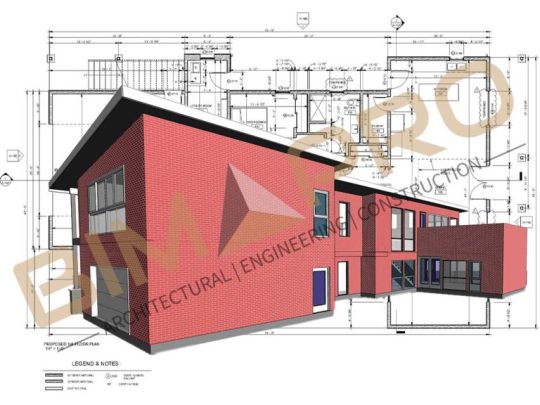#ConvertPDFtoBIMModel
Explore tagged Tumblr posts
Text
How to Effortlessly Convert PDF to BIM Model?

In the ever-evolving world of architecture, engineering and construction, efficiency is key. Building Information Modeling (BIM) has revolutionized the way projects are designed and executed, allowing for better collaboration and decision-making. However, one of the common challenges faced by professionals in this industry is the conversion of PDF to BIM models. In this article, we will explore how PDF to BIM Services streamlining your workflow and saving valuable time and resources.
Understanding the Importance of PDF to BIM Conversion
1. The Significance of BIM in Modern Construction
BIM has emerged as a powerful and transformative method in modern design and construction. It involves the creation of detailed 3D model with digital representations of buildings and infrastructure. These models not only serve as visualizations but also store essential information about the project, from design and materials to costs and scheduling. The significance of BIM lies in its ability to facilitate collaboration, reduce errors, and improve project outcomes. It enables architects, engineers, contractors, and other stakeholders to work on a shared platform, making it easier to detect and address potential issues before they become costly problems during construction.
2. The Challenge of PDF Documents
While BIM has become the industry standard for project planning and execution, many architectural plans, and designs are still presented in the Portable Document Format (PDF). PDFs have been widely used for their compatibility and ease of sharing, but they lack the intelligence and interactivity that BIM offers. This separate between PDF documents and BIM technology can lead to inefficiencies in the design and construction process. Architects and contractors often find themselves manually transcribing information from PDF into BIM software, a time-consuming and error-prone task. As a result, there is a growing demand for solutions that can bridge the gap between these two formats.
The Process of Converting PDF to BIM Models
Effortlessly converting PDF to BIM models requires a systematic approach and the right tools. Let’s break down the process step by step:
Industries Benefiting from PDF to BIM Conversion
PDF to BIM conversion has far-reaching implications that benefits several industries within the design and construction ecosystem. Let’s take a closer look at how various sectors can leverage this technology:
1. Architectural
Architects can seamlessly integrate PDF plans into their BIM workflows. This integration streamlines the design process, making it easier to iterate on designs and incorporate changes. Architects can focus on the creative aspects of their work while leaving the technical conversion to the software.
By eliminating the need for manual data entry, architects can spend more time refining their designs and exploring innovative solutions. This not only improves the quality of architectural projects but also enhances their efficiency.
2. Engineering
Engineers play a critical role in the construction process, and the integration of PDF to BIM conversion is equally valuable to them. Engineering firms can use BIM models generated from PDFs to validate and refine their structural and mechanical designs. This ensures that all engineering components align with the architectural plans, reducing the risk of clashes and design errors.
Additionally, engineers can simulate the performance of systems within the BIM environment, allowing for advanced analysis of structural integrity, energy efficiency, and more. This level of integration between PDF and BIM streamlines the engineering phase of construction projects, resulting in more robust and cost-effective designs.
3. Construction
Construction professionals, including contractors and subcontractors, benefit significantly from effortless PDF to BIM conversion. Construction projects involve a multitude of stakeholders, each with their own set of plans and documents. Coordinating these documents and ensuring they align with the BIM model is a challenging task.
BIM conversion simplifies this process. It ensures that everyone is working from the same set of accurate data, reducing conflicts, and discrepancies. Contractors can also use BIM models for clash detection, identifying and resolving issues before they cause delays or cost overruns.
4. Facility Management
PDF to BIM conversion extends its benefits beyond the construction phase to facility management. Facility managers are responsible for the ongoing maintenance and operation of buildings. Having access to accurate BIM models generated from PDFs can be invaluable in this role.
The Future of PDF to BIM Conversion As technology continues to advance, we can expect continuous improvements in PDF to BIM conversion methods. Here are some key trends and developments to watch for in the future:
Continuous Advancements in Technology
Integration with Cloud-Based Platforms
Enhanced Mobile Solutions
Conclusion
Converting PDF to BIM models is a game-changing solution for the architecture and construction industry. It bridges the gap between traditional document formats and modern BIM workflows, offering significant advantages in terms of time savings, accuracy, and collaboration. As technology continues to advance, we can look forward to even more streamlined processes in the future.
In a world where construction projects grow increasingly complex and time-sensitive, the ability to effortlessly convert PDF to BIM models is a competitive advantage that cannot be ignored. Therefore, embracing BIM Modeling Services in your projects is not just about staying ahead of the curve; it’s about delivering better projects, reducing costs, and ultimately, transforming the way we build the world around us.
1 note
·
View note